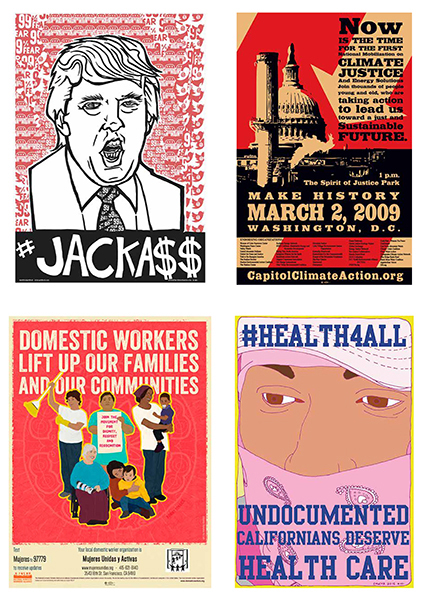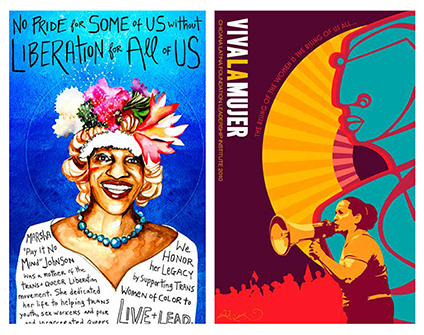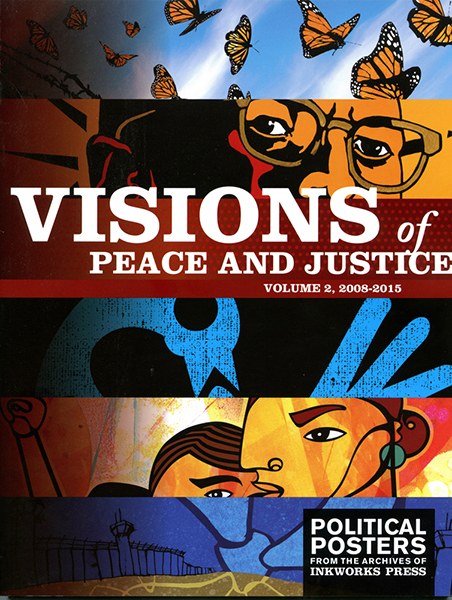Reflections on the body of work that is Inkworks Press’ posters
By Lincoln Cushing
This recently appeared as the Afterword in Visions of Peace & Justice: political posters from Inkworks Press, Volume 2.
This second volume of exemplary posters printed at Inkworks Press closes an important chapter in movement media history. The first book covered the years 1974 to 2007; this supplement brings us up to 2015. A lot has happened in the world during those years.
Some qualities of these posters are invisible to the reader, but reflect hugely on the changes in print media that have taken place. Most posters made until the early 1990s were created by graphic artists “the old fashioned way” – they were drawn with ink on paper, the typography and headlines were sent out to a professional and pasted up, and the photographic elements were sized and shot – in short, a complex and tedious process. Behind the scenes, skilled workers at print shops like Inkworks would receive all the parts, put them together, and hope that the pre-press proof was correct. All that before ink ever hit paper.

Top L-R: Visions2-Ch3-51-1 “#Jacka$$” Jon-Paul Bail, 2015; Visions2-Ch6-78-1
“First National Mobilization on Climate Change” Cesar Maxit, 2009. Bottom row L-R: Visions2-Ch1-16-1 “Domestic workers lift up our families and our communities” Rommy Torrico, 2015; Visions2-Ch3-39-1 “Undocumented Californians deserve health care” Chucha Marques, 2015
But the digital revolution utterly transformed that. By the mid-1990s designers, with affordable computers and scanners, could create art with their own typography, their own photos, their own proofed documents, ready to reproduce. The costs of color reproduction dropped. Some of the revolutionary prophecies that the personal computer could democratize communication were true.
But one prediction was wrong – that the digital age would make posters obsolete. After all, why bother with a static graphic when you can just as easily make a free colorful video and share it with the world? Wrong. Activists still need posters. Ink on paper not only survived, it thrived.
What we see here is the glorious fruit of the Bay Area’s huge pool of graphic talent, the deep history of social justice work, and the presence of skilled and sympathetic reproduction facilities such as Inkworks Press.

L-R: Visions2-Ch5-72-1 “No pride for some of us without liberation for all of us” Micah Bazant, 2015; Visions2-Ch4-52-3 “Chicana Latina Foundation leadership institute” Favianna Rodriguez, 2010
Inkworks was an integral part of a rich progressive publishing ecosystem. It served nobly and well, fueled by a dedicated collective. Another link in the long tradition of printing to make a difference has been closed, and surely others will open.
Behold these paper bullets. Behold the thunder of the press.
-Lincoln Cushing, Inkworks collective member 1981-2001
___________________________◊◊◊___________________________

This magnificent collection of posters is of immense value as a graphic record of progressive political activity in the San Francisco/Oakland Bay Area over the last several decades. Inkworks has been the key player in creating some of the most aesthetically rich and politically incisive posters in the post-60s era, and this selection will be of great interest to activists, historians, social scientists, and any one else interested in social protest. This volume and the previously published volume 1, reflect both the emotional power and the ideological clarity of of movements against racism, sexism, and homo/trans/phobia, as well as struggles for immigration reform, peace in the Middle East, and for abolition of the prison industrial complex, among other issues. The posters are executed in a variety of styles representing a range of influence, yet all bear the special mark of the highly gifted graphic artists who work have worked with the Inkworks collective. The Bay Area has a large Latino population, and the influence of Latin American poster styles is apparent in many of the pieces. While especially important in relation to the Northern California region, the movements covered are national and international as well, and thus the importance of the collection goes beyond its immediate subject. Any one interested in the relation of art and protest should have a copy of this volume and the one that preceded it.